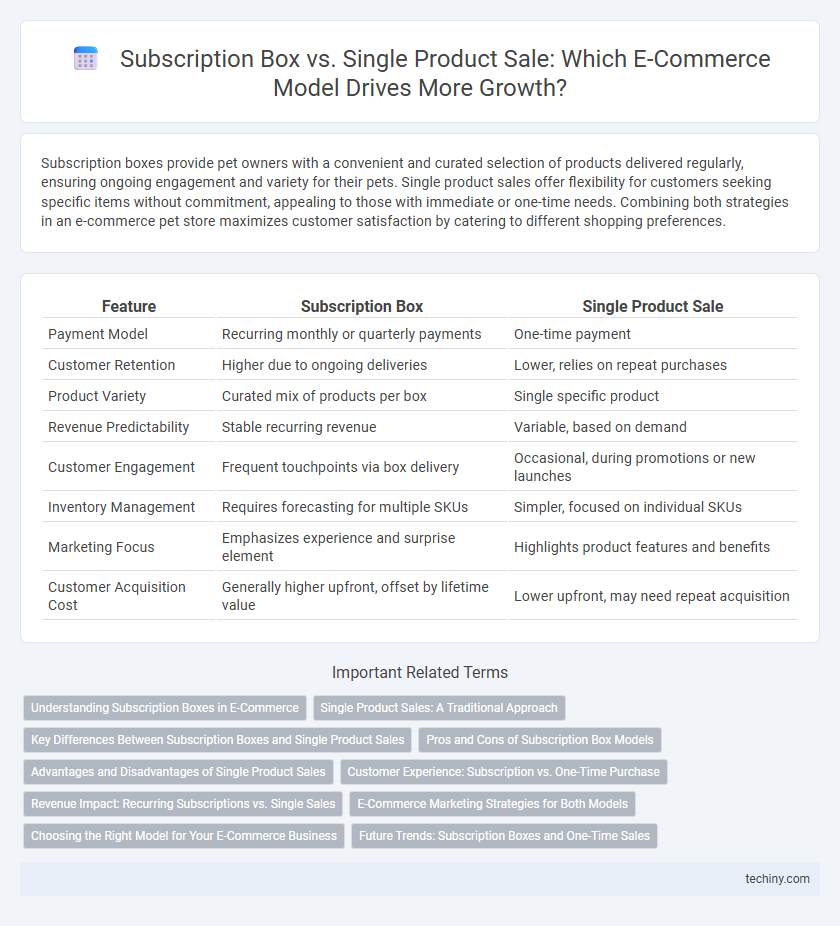Subscription boxes provide pet owners with a convenient and curated selection of products delivered regularly, ensuring ongoing engagement and variety for their pets. Single product sales offer flexibility for customers seeking specific items without commitment, appealing to those with immediate or one-time needs. Combining both strategies in an e-commerce pet store maximizes customer satisfaction by catering to different shopping preferences.
Table of Comparison
| Feature | Subscription Box | Single Product Sale |
|---|---|---|
| Payment Model | Recurring monthly or quarterly payments | One-time payment |
| Customer Retention | Higher due to ongoing deliveries | Lower, relies on repeat purchases |
| Product Variety | Curated mix of products per box | Single specific product |
| Revenue Predictability | Stable recurring revenue | Variable, based on demand |
| Customer Engagement | Frequent touchpoints via box delivery | Occasional, during promotions or new launches |
| Inventory Management | Requires forecasting for multiple SKUs | Simpler, focused on individual SKUs |
| Marketing Focus | Emphasizes experience and surprise element | Highlights product features and benefits |
| Customer Acquisition Cost | Generally higher upfront, offset by lifetime value | Lower upfront, may need repeat acquisition |
Understanding Subscription Boxes in E-Commerce
Subscription boxes in e-commerce offer curated collections of products delivered regularly, enhancing customer retention and lifetime value compared to single product sales. These boxes provide personalized experiences by leveraging customer data and preferences, driving higher engagement and recurring revenue streams. Brands benefit from predictable cash flow and efficient inventory management through subscription models, distinguishing them from traditional one-time purchases.
Single Product Sales: A Traditional Approach
Single product sales remain a cornerstone of e-commerce, offering customers immediate ownership without long-term commitments. This traditional approach simplifies inventory management and caters to buyers seeking specific items without recurring costs. Data shows that single product sales drive significant revenue, especially in niche markets where consumer preference leans toward one-time purchases.
Key Differences Between Subscription Boxes and Single Product Sales
Subscription boxes offer recurring delivery of curated products, providing convenience and personalized experiences, while single product sales involve one-time purchases of individual items. Subscription models drive customer retention and steady revenue through recurring billing, whereas single product sales depend on individual transactions without guaranteed repeat business. The packaging and marketing strategies also differ, with subscription boxes emphasizing variety and discovery, contrasting the straightforward focus on a single product's features.
Pros and Cons of Subscription Box Models
Subscription box models generate consistent monthly revenue and enhance customer retention through curated product experiences, making them ideal for brands aiming to build long-term loyalty. However, subscription services face challenges like high customer acquisition costs, potential subscriber fatigue, and complexities in inventory management. Balancing personalized offerings with scalable logistics is essential to maximize the profitability and sustainability of subscription box e-commerce businesses.
Advantages and Disadvantages of Single Product Sales
Single product sales offer immediate revenue and simpler inventory management, attracting customers seeking specific items without ongoing commitments. However, they lack the recurring income and customer retention benefits seen in subscription models, potentially increasing marketing costs to maintain steady sales. Single sales also limit opportunities for building long-term customer relationships and predictive sales analytics.
Customer Experience: Subscription vs. One-Time Purchase
Subscription boxes offer personalized, recurring deliveries that enhance customer convenience and foster long-term brand loyalty through curated experiences. One-time purchases provide immediate gratification and flexibility, appealing to customers seeking specific products without commitment. The subscription model leverages data-driven customization, resulting in a more engaging and tailored customer journey compared to single product sales.
Revenue Impact: Recurring Subscriptions vs. Single Sales
Recurring subscriptions generate steady revenue streams by ensuring customer retention and predictable cash flow, significantly enhancing lifetime customer value compared to single product sales. Subscription boxes foster ongoing engagement, increase average order value, and reduce churn through curated experiences tailored to customer preferences. Single sales rely on frequent acquisition efforts and often encounter revenue volatility, limiting growth potential relative to the compounding benefits of subscription models.
E-Commerce Marketing Strategies for Both Models
Subscription box marketing leverages recurring revenue by emphasizing customer retention, personalized content, and exclusive offers to boost lifetime value. Single product sales in e-commerce rely heavily on targeted advertising, SEO optimization, and seasonal promotions to drive immediate conversions and maximize average order value. Integrating data analytics and customer feedback enhances both models' marketing strategies by enabling personalized recommendations and dynamic pricing adjustments.
Choosing the Right Model for Your E-Commerce Business
Subscription box models ensure recurring revenue streams and enhance customer retention through curated, personalized experiences, ideal for businesses aiming to build long-term loyalty. Single product sales focus on one-time purchases, providing simplicity and immediate cash flow, best suited for niche markets or high-ticket items with unique value propositions. Analyzing customer behavior, product type, and cash flow needs helps determine the optimal sales strategy to maximize profitability and growth.
Future Trends: Subscription Boxes and One-Time Sales
Subscription boxes are projected to grow annually by 15% through 2028, driven by consumer demand for personalized, curated experiences and convenience. In contrast, one-time sales remain essential for impulse purchases and niche markets, with emerging AI tools enabling precise targeting to boost conversion rates. Integrating subscription models with data analytics promises enhanced customer retention and predictive inventory management, shaping the future of e-commerce sales strategies.
Subscription Box vs Single Product Sale Infographic

 techiny.com
techiny.com